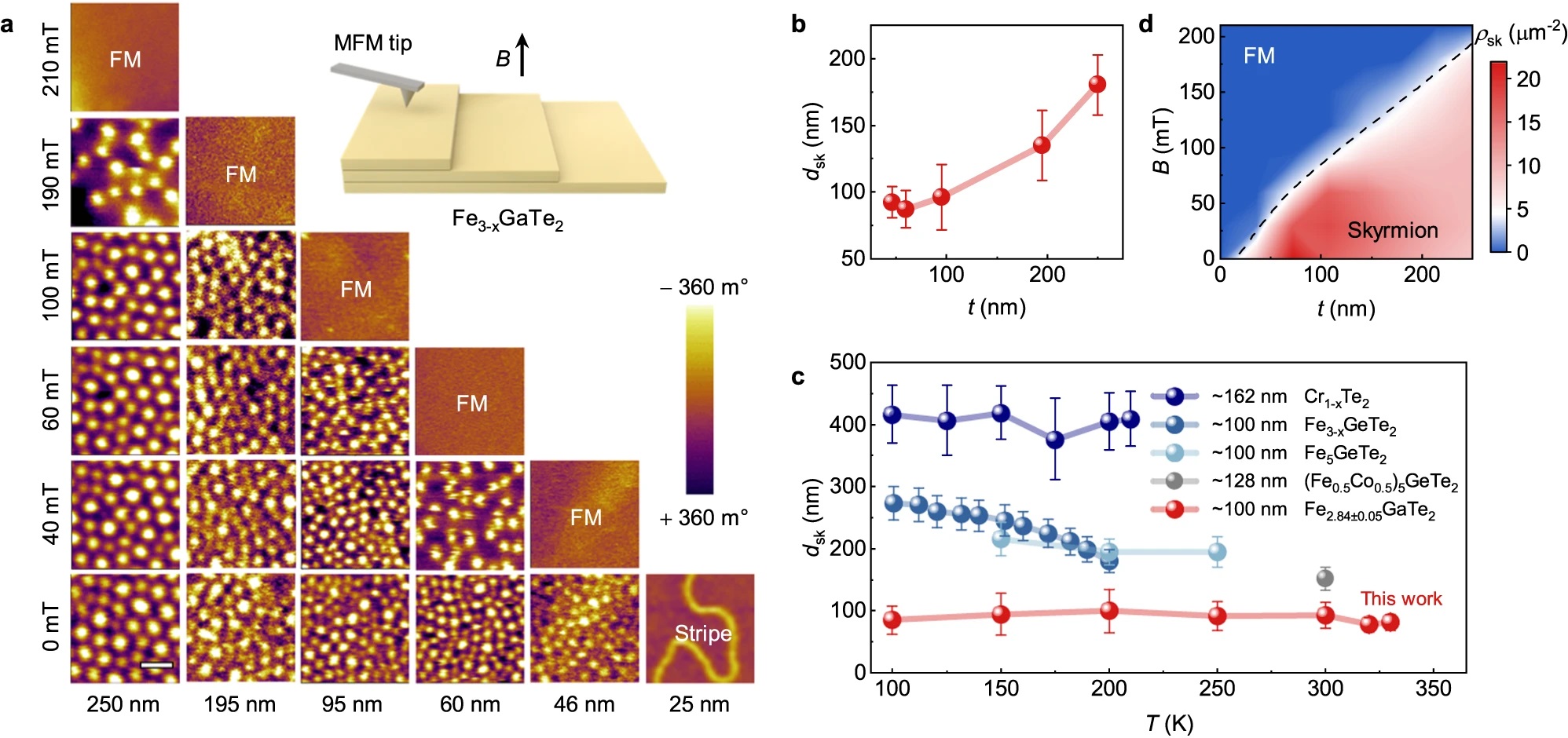The small size and magnetoelectronic properties of magnetic skyrmions make them promising candidates as data carriers for future high-density and fast-speed data storage, quantum and neuromorphic computation. *
Because of their unique atomic layered structure, two-dimensional (2D) van der Waals (vdW) ferromagnets have some advantages when using them for practical applications in spintronic devices compared to 3D bulk ferromagnets. *
Therefore, the study of magnetic skyrmions with small sizes, especially at room temperature (RT), in 2D vdW ferromagnetic materials with easy tunability has become a focal point of magnetic and topological order of matters, as well as spintronic applications. *
In the article “Room-temperature sub-100 nm Néel-type skyrmions in non-stoichiometric van der Waals ferromagnet Fe3-xGaTe2 with ultrafast laser writability” Zefang Li, Huai Zhang, Guanqi Li, Jiangteng Guo, Qingping Wang, Ying Deng, Yue Hu, Xuange Hu, Can Liu, Minghui Qin, Xi Shen, Richeng Yu, Xingsen Gao, Zhimin Liao, Junming Liu, Zhipeng Hou, Yimei Zhu and Xuewen describe how they discovered that the iron deficiency in Fe3GaTe2 can lead to a pronounced displacement of the Fe atoms within the crystal structure.*
Based on systematic structural analysis and first-principles calculations, Zefang Li et al. find that this atomic displacement causes a transformation from the original centrosymmetric crystal structure to a non-centrosymmetric structure, resulting in a significant Dzyaloshinskii–Moriya interactions (DMI). *
They report the discovery of a field-free sub-100 nm Néel-type skyrmion state in non-stoichiometric Fe2.84±0.05GaTe2 over a broad temperature range from 330 K to 100 K. *
Lorentz transmission electron microscopy (LTEM) (along with along with magnetic force microscopy (MFM) shows the size of the skyrmions decreases with sample thickness, and a field-free sub-100 nm skyrmion state was achieved at RT within a specific sample thickness range of 40 nm to 60 nm. *
Magnetic force microscopy (MFM), which is sensitive to the out-of-plane magnetic field in the sample, was used by Zefang Li et al. to study the effect of nanoflake thickness on the stabilization of the skyrmion phase at room temperature after field-cooling manipulation. *
All the nanoflakes used for the magnetic force microscopy (MFM) measurements were freshly exfoliated from the same batch to ensure consistency. *
In order to minimize the influence of the AFM tip’s magnetic field on the domain structures during scanning the authors used NANOSENSORS PPP-LM-MFMR low-moment magnetic AFM probes.
These MFM probes are designed for magnetic force microscopy with reduced disturbance of the magnetic sample by the AFM tip and enhanced lateral resolution – compared to the standard MFM probes .*
The MFM measurements were carried out in an environment continuously flushed with argon gas to ensure effective protection.*
To further enhance the practical applications of their findings, Zefang Li et al. employed a homemade in-situ optical Lorentz transmission electron microscope to demonstrate ultrafast writing of skyrmions in Fe3-xGaTe2 using a single femtosecond laser pulse.*
The article by Zefang Li et al. demonstrates not only the non-stoichiometric Fe2.84±0.05GaTe2 to be a promising material platform for exploring magnetic skyrmions, but also that fs-laser can be a powerful tool to manipulate and control topological chiral spin textures to realize skyrmion-based high-speed logic and memory applications.*

Fig. 4 from Zefang Li et al. (2024) “Room-temperature sub-100 nm Néel-type skyrmions in non-stoichiometric van der Waals ferromagnet Fe3-xGaTe2 with ultrafast laser writability”:
Thickness-tunable skyrmions imaged by MFM.
a Typical MFM images of RT skyrmions taken at different thicknesses and external magnetic fields. In these images, bright contrast in the images corresponds to spin down, while dark contrast corresponds to spin up relative to the sample normal direction. The inset shows the schematic for the MFM experiment with magnetic field perpendicular to the sample plane. b RT skyrmion diameter dsk versus sample thickness t at zero field. c Comparison for diameter dsk of field-free skyrmions and temperature T for various 2D vdW materials with a thickness around 100 nm, including Cr1+xTe234, Fe3-xGeTe255, Fe5GeTe224, (Fe0.5Co0.5)5GeTe231, and Fe2.84±0.05GaTe2 in this work. Error bars represent the standard error of skyrmion sizes averaged at various temperature. d Thickness and magnetic field dependence of RT skyrmion phase diagram. The color indicates the skyrmion density ρsk. The black dashed line shows the boundary between skyrmion and ferromagnetic phase.
* Zefang Li, Huai Zhang, Guanqi Li, Jiangteng Guo, Qingping Wang, Ying Deng, Yue Hu, Xuange Hu, Can Liu, Minghui Qin, Xi Shen, Richeng Yu, Xingsen Gao, Zhimin Liao, Junming Liu, Zhipeng Hou, Yimei Zhu and Xuewen Fu
Room-temperature sub-100 nm Néel-type skyrmions in non-stoichiometric van der Waals ferromagnet Fe3-xGaTe2 with ultrafast laser writability
Nature Communications volume 15, Article number: 1017 (2024)
DOI: https://doi.org/10.1038/s41467-024-45310-2
Please follow this external link to read the full article: https://rdcu.be/dJlP4
Open Access: The article “Room-temperature sub-100 nm Néel-type skyrmions in non-stoichiometric van der Waals ferromagnet Fe3-xGaTe2 with ultrafast laser writability” by Zefang Li, Huai Zhang, Guanqi Li, Jiangteng Guo, Qingping Wang, Ying Deng, Yue Hu, Xuange Hu, Can Liu, Minghui Qin, Xi Shen, Richeng Yu, Xingsen Gao, Zhimin Liao, Junming Liu, Zhipeng Hou, Yimei Zhu and Xuewen Fu is licensed under a Creative Commons Attribution 4.0 International License, which permits use, sharing, adaptation, distribution and reproduction in any medium or format, as long as you give appropriate credit to the original author(s) and the source, provide a link to the Creative Commons license, and indicate if changes were made. The images or other third party material in this article are included in the article’s Creative Commons licence, unless indicated otherwise in a credit line to the material. If material is not included in the article’s Creative Commons licence and your intended use is not permitted by statutory regulation or exceeds the permitted use, you will need to obtain permission directly from the copyright holder. To view a copy of this licence, visit https://creativecommons.org/licenses/by/4.0/.